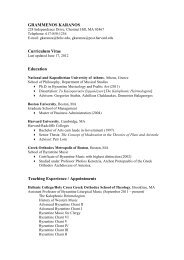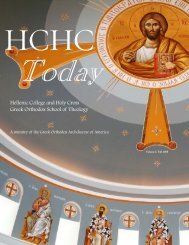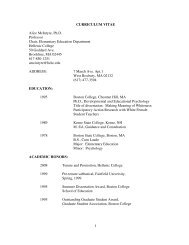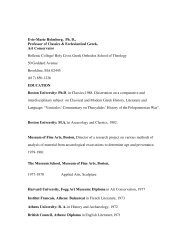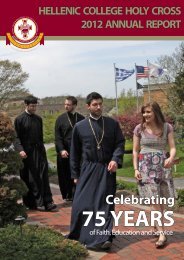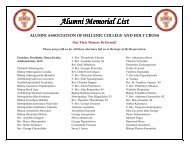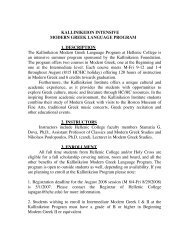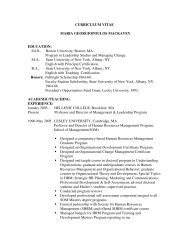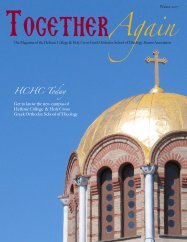Celebrating Sacred Art - Hellenic College
Celebrating Sacred Art - Hellenic College
Celebrating Sacred Art - Hellenic College
You also want an ePaper? Increase the reach of your titles
YUMPU automatically turns print PDFs into web optimized ePapers that Google loves.
Orthodox Christian<br />
Spiritual Formation<br />
The classroom, called the Children’s Room, is a<br />
specially prepared environment designed to satisfy the<br />
child’s natural inclination to movement and to spirituality<br />
by providing hands-on biblical and liturgical activity. Once<br />
the activity has been demonstrated by the teacher, the<br />
children are free to repeat it, to retell the Bible stories while<br />
manipulating the pieces, and to proceed to other connected<br />
activity for carefully selected biblical stories, Orthodox<br />
hymns, prayers, and liturgical traditions.<br />
The program is designed to address a most sensitive<br />
time for spiritual formation, ages three to six, providing an<br />
authentic Orthodox experience where the spiritual child<br />
is honored, nurtured, and given a place for reflection and<br />
expression of faith. When movement and mental activity<br />
are combined, the child is able to give himself totally to<br />
the present moment, resulting in enhanced concentration.<br />
The body, mind, and heart of the young child act in<br />
unison, as they have not yet reached the age of reason and<br />
division among their parts. Mental, spiritual, and physical<br />
developments are interconnected and interdependent.<br />
Children hear the Word of God and experience worship with<br />
their whole beings. The hearts of children are naturally able<br />
to realize God. The Children’s Room supports the child’s<br />
discovery of the presence of God.<br />
As one OCSF graduate states, “Sharing this with<br />
the children sometimes feels like all I’m doing is giving<br />
them language for what they already know, like all I did<br />
was create a place for them to express it. They get the<br />
opportunity to actively engage with the Faith and with<br />
Christ, while I get the opportunity to observe the simple and<br />
natural way in which they do so. We help each other love<br />
God, the Church He gave us, and one another in the Body of<br />
Christ, a little bit more every time we’re together.”<br />
Upon going into church and seeing that which has<br />
become familiar, children become most at home in the<br />
House of God. They build awareness of the role the priest,<br />
that of his vestments, even liturgical items and gestures,<br />
church hymns, biblical stories, and feast days. It is so<br />
beautiful to observe children as they spontaneously recall<br />
and name the Archangel Gabriel and the Holy Theotokos<br />
After the reading of the Holy Bible, the Parable of the Good Shepherd<br />
materials are manipulated as the parable is retold<br />
upon viewing an icon of the Evangelismos. They remember<br />
the story because it was read to them from the Holy Bible, and<br />
while retelling the story, they were able to manipulate the icon<br />
figures provided in the Children’s Room.<br />
Impressions received between birth and age six can be<br />
life-lasting. No other language is learned as well or as easily<br />
as the mother tongue, because it has been learned during the<br />
sensitive period of language formation. Faith experienced<br />
during the sensitive period of spiritual formation can be forever.<br />
The child before six years of age is in a unique formation<br />
period. It is the role of the adult to provide the environment<br />
that nurtures the youngest members of our Church.<br />
How does this ministry serve adults<br />
Orthodox faithful are called to serve the Church.<br />
Some as clergy, others are lay assistants, youth advisors, choir<br />
members, and a variety of volunteer opportunities. Orthodox<br />
Christian spiritual formation provides another vital ministry,<br />
serving the young child and the family. Bringing the faith<br />
experience for family discussions, the program builds a lifelong<br />
relationship between the child, his/her family, and the Church.<br />
This is one of the central tenets explored in the course.<br />
Together Again December 2012 31



